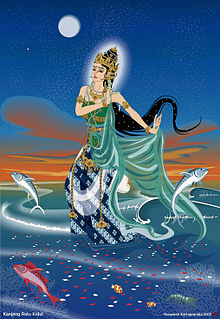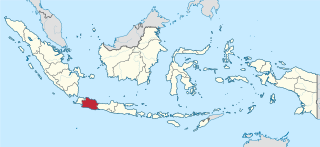
West Java is an Indonesian province on the western part of the island of Java, with its provincial capital in Bandung. West Java is bordered by the province of Banten and the country's capital region of Jakarta to the west, the Java Sea to the north, the province of Central Java to the east and the Indian Ocean to the south. With Banten, this province is the native homeland of the Sundanese people, the second-largest ethnic group in Indonesia.

Parangtritis Beach is a tourist beach on the southern coast of Java, in the Bantul Regency within the Special Region of Yogyakarta, Indonesia. There is a road to the area which is about 30 km south of the city of Yogyakarta. This beach is located south of Parangkusumo Beach, which is also a mainstay of tourism in Bantul Regency. This beach is often visited by local and foreign tourists.

Suzzanna Martha Frederika van Osch was an Indonesian actress. Known as the "Queen of Indonesian horror", she is well-known in particular in Indonesia for portraying spirits, witches, and other supernatural beings. She was crowned the best female antagonist in Indonesian film industry along with Ruth Pelupessy and Mieke Wijaya.

The bedhaya is a sacred, ritualised Javanese dance of Java, Indonesia, associated with the royal palaces of Yogyakarta and Surakarta. Along with the srimpi, the bedhaya epitomized the elegant character of the royal court and became an important symbol of the ruler's power.

Joglo is a type of traditional vernacular house of the Javanese people. The word joglo refers to the shape of the roof. In the highly hierarchical Javanese culture, the type of roof of a house reflects the social and economic status of the owners of the house; joglo houses are traditionally associated with Javanese aristocrats.

Folklore of Indonesia is known in Indonesian as dongeng, cerita rakyat or folklor, refer to any folklore found in Indonesia. Its origins are probably an oral culture, with a range of stories of heroes associated with wayang and other forms of theatre, transmitted outside of a written culture. Folklore in Indonesia are closely connected with mythology.

Palabuhanratu or Pelabuhan Ratu is a district and fishing town which serves as the regency seat of Sukabumi Regency. It is at the southwest coast of Palabuhanratu Bay, West Java facing the Indian Ocean. It is a four-hour drive from Bandung and up to a 12-hour drive from Indonesia's capital Jakarta due to traffic jams in Ciawi, Cicurug, Cibadak and Pelabuhan Ratu gate, whose residents love to visit the bay 'Teluk Palabuhanratu', once named 'Wijnkoopersbaai' by the Dutch. The bay is shaped like a horseshoe and has enormous waves that can be very treacherous. The Sundanese locals say that the Indian Ocean is the home of Nyai Loro Kidul who reigns along the southern coast of Java.

The Sultanate of Cirebon was an Islamic sultanate in West Java founded in the 15th century. It is said to have been founded by Sunan Gunungjati, as marked by his letter proclaiming Cirebon's independence from Pajajaran in 1482, although the settlement and the polity had been established earlier, in 1445. Sunan Gunungjati also established the Sultanate of Banten. It was one of the earliest Islamic states established in Java, along with the Sultanate of Demak.
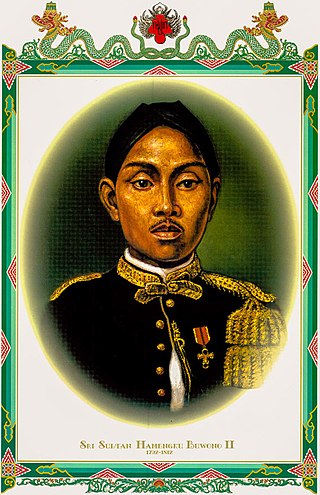
Hamengkubuwono II, born Raden Mas Sundoro, was the second sultan of Yogyakarta 1792–1810, 1811–12 and finally 1826–28 during the Java War.

The Legend of Roro Jonggrang is a Javanese popular legend (folktales) from Central Java telling the story of love and betrayal, the warrior and the cursed princess. It also explains the mythical origin of Ratu Boko palace, Sewu temple, and the Durga statue in Prambanan temple compound. The title Roro is an ancient honorific title to address unmarried princesses and female nobility, thus the name Rara Jonggrang in Javanese means 'slender maiden'.
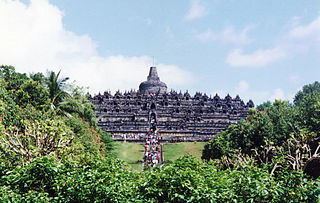
Dewi Sri or Shridevi is the Javanese, Sundanese, and Balinese Hindu Goddess of rice and fertility, still widely worshiped on the islands of Java, Bali and Lombok, Indonesia. She is often associated or equated with the Hindu goddess Lakshmi, the shakti (consort) of Vishnu.
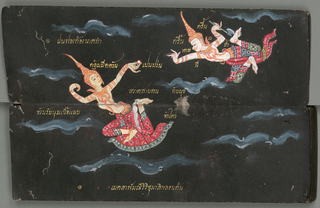
Manimekhala is a goddess in the Buddhist mythology. She is regarded as a guardian of the seas, namely the Indian Ocean and the South China Sea as part of the mythology of Southeast Asia. She was placed by Cātummahārājika to protect virtuous beings from shipwreck. She appears in several Buddhist stories including the Mahanipata Jataka, in which she rescues Prince Mahajanaka from a shipwreck.

The mythology of Indonesia is very diverse, the Indonesian people consisting of hundreds of ethnic groups, each with their own myths and legends that explain the origin of their people, the tales of their ancestors and the demons or deities in their belief systems. The tendency to syncretize by overlying older traditions with newer foreign ideas has occurred. For example, the older ancestral mythology might be merged with foreign mythology, such as Hindu, Islam, or Christian biblical mythology.

King Siliwangi or Prabu Siliwangi was a semi-legendary great king of the Hindu Sunda kingdom before the coming of Islam in West Java.
Dewi Lanjar is an Indonesian goddess of the sea, the opposite of Nyai Roro Kidul and the Queen of the Northern Sea, according to Javanese beliefs. She is a popular goddess in the city of Pekalongan, Central Java. Her name "Lanjar" means a woman who is divorced and have no children.
Panembahan Senapati, formally styled Panembahan Senapati ing Ngalaga Sayyidin Panatagama, was the founder of the Mataram Sultanate.

Tarawangsa is a traditional Sundanese musical instrument from West Java, Indonesia, in the form of a stringed instrument that has two strings made of steel or iron wire. Tarawangsa is an ensemble of chordophones of two musical instruments. One is called tarawangsa itself, played by swiping and the other is called jentreng played by picking. The art of Tarawangsa is performed in the Ngalaksa ceremony, which is a ceremony for abundant harvests. The ceremony in the traditional agrarian society of the Sundanese is always identified with the figure of Nyai Sri Pohaci or Nyi Pohaci Sanghyang Dangdayang Asri or Dewi Asri or Dewi Sri as the Sundanese goddess of rice.
